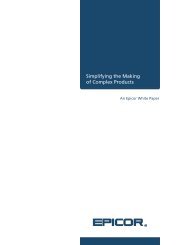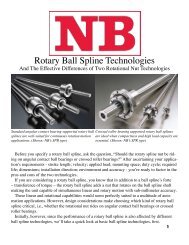Turbo Chain: A New Recovery System Beyond Ethernet ... - Technolec
Turbo Chain: A New Recovery System Beyond Ethernet ... - Technolec
Turbo Chain: A New Recovery System Beyond Ethernet ... - Technolec
Create successful ePaper yourself
Turn your PDF publications into a flip-book with our unique Google optimized e-Paper software.
Moxa White Paper<strong>Turbo</strong> <strong>Chain</strong>: A <strong>New</strong> <strong>Recovery</strong> <strong>System</strong> <strong>Beyond</strong> <strong>Ethernet</strong>Redundant Ring TechnologySean Wang, Product Managersupport@moxa.comOverviewThis white paper willexplore the variouschallenges presented byexisting redundantnetworking technologiesand introduce a newredundant solution thatresolves many existingproblems.In recent years, redundant <strong>Ethernet</strong> technology has beenrapidly and popularly adopted in the industrial automation fielddue to its enhanced reliability. However as a redundantnetwork becomes more heavily utilized, its networkingrequirements consequently grow more demanding, makingsome of the redundant technologies (such as simple ringtopology) inefficient in certain situations. This problem haspresented redundant technology with a functional challengebecause an ideal redundant <strong>Ethernet</strong> solution should becapable of supporting multiple redundant connections. In thiswhite paper, we’ll first introduce the standard redundanttechnologies. Next, we’ll unveil a new breakthrough redundanttechnology that can be applied to increase the efficiency andavailability of multiple redundant connections in industrialapplications, followed by some scenarios to describe thebenefits of adopting new redundant solutions.Released on October 5, 2009Copyright © 2009 Moxa Inc., all rights reserved.Moxa manufactures one of the world’s leading brands of device networking solutions. Products include industrialembedded computers, industrial <strong>Ethernet</strong> switches, serial device servers, multiport serial boards, embeddeddevice servers, and remote I/O solutions. Our products are key components of many networking applications,including industrial automation, manufacturing, POS, and medical treatment facilities.How to contact MoxaTel: 1-714-528-6777Fax: 1-714-528-6778Web: www.moxa.comEmail: info@moxa.comThis document was produced by the Moxa Technical WritingCenter (TWC). Please send your comments or suggestionsabout this or other Moxa documents to twc@moxa.com.
Moxa White PaperMoxa <strong>Turbo</strong> <strong>Chain</strong>Building High-availability Redundant NetworksEase of deployment, highavailability, rapid failurerecovery, and futureexpandability areimportant features forindustrial redundant<strong>Ethernet</strong> networks.For industrial <strong>Ethernet</strong> redundant networks, one of the mostcommon problems encountered today is the lack of atechnology to easily build high-availability networks containingcomplex redundant connections. Nonetheless, thisrequirement is still highly needed in various industrial fields(e.g., wind power, oil pipelines, and railway automationnetworks). In these applications, large <strong>Ethernet</strong> networks withnetwork redundancy are often required, and the network mayencompass multiple locations over substantial distances andrequire more flexible topologies.In addition to the above, other problems such as troublesomenetwork expansions or slow failure-recovery are alsofrequently encountered. As we go over the advantages anddisadvantages of the standard redundant technologies, we’lldiscuss how Moxa’s latest technology, <strong>Turbo</strong> <strong>Chain</strong>, can addressthese issues precisely and efficiently.Network Redundancy TechnologiesThere are many existing mechanisms that can enhancefault-tolerance in an <strong>Ethernet</strong> network. The most common ofthese are Mesh networking, STP, RSTP, and proprietary ringredundancy.Mesh networking isreliable and robust, buthas very high cost duein large part to thecabling requirements.• Mesh NetworkingA mesh network is a network where all the nodes are connectedto each other in a complete network. Every node is connectedto other nodes on the network through hops. Some areconnected through a single hop and some may be connectedwith more than one hop. Data traveling on the mesh network isautomatically configured to reach the destination by taking theshortest route. Mesh networking is reliable and isself-repairing. If one node fails, the network finds an alternateroute to transfer the data. In a mesh network, it is highlyunlikely that all the nodes in a single network will break downat any given point of time. Although mesh networking is highlyCopyright © 2009 Moxa Inc. Page 2 of 11
Moxa White PaperMoxa <strong>Turbo</strong> <strong>Chain</strong>reliable and robust for data transmission, it has a highercommunications overhead and there are increased costs fromthe cables required to connect all the nodes to each other.Figure 1: Mesh NetworkingSTP has reducedcabling requirementscompared to a meshnetwork, but itsrecovery time is slowand unsuitable forindustrial applications.• Spanning Tree Protocol (STP)Spanning Tree Protocol as defined in the IEEE 802.1D standardis designed to eliminate loops in a network by cutting thenetwork into a loop-free tree shape. It helps a network achievelink redundancy and path optimization. The network shown inFigure 2 is an example of a redundant <strong>Ethernet</strong> network thatuses STP and includes a loop between switches 1 to 5. STP usesan algorithm to find redundant links in a network and allowcertain paths as backup paths to prevent looping. When STP isrunning, packets sent from switch 5 to the root switch will gothrough switch 3. When switch 3 disconnects or fails, STP thenautomatically re-arranges the connections by activating thebackup paths to forward data.Figure 2: Spanning Tree Protocol blocks redundant ports toresolve loopsCopyright © 2009 Moxa Inc. Page 3 of 11
Moxa White PaperMoxa <strong>Turbo</strong> <strong>Chain</strong>Although STP resolves looping and achieves networkredundancy, it has some drawbacks. One of these is slowrecovery time; with STP, recovery usually takes 15 secondsafter the spanning tree is established. This recovery time is toolong for industrial applications.RTSP improvessomewhat on STP’sslow recovery time, butremains unsuitable formany mission criticalapplications.• Rapid Spanning Tree Protocol (RSTP)To overcome the slow convergence of STP, the IEEE releasedthe IEEE 802.1w standard to make improvements based onSTP. This shortened the recovery speed to 1 second. However,for some real-time and mission critical industrial applications,such as military and process control systems, recovery timemust be under 100 milliseconds to ensure the reliability of thenetwork.STP & RSTP are open standards that many <strong>Ethernet</strong> switchmanufacturers have implemented in their managed switchproducts. The faster self-healing time of RSTP is very helpful inan enterprise network where a few seconds of network delay isacceptable. However in an industrial control network, onesecond of missed communications can cause serious problems.Factory automation applications typically involve machineryrequiring much shorter fail over times. This is required for safeoperation of the processes being controlled and to preventexpensive system downtime.Ring redundancy is acost-effective solutionwith excellent recoverytimes, but haslimitations ininteroperability andexpandability.• Proprietary Ring RedundancyRing redundancy is common among today’s industrial <strong>Ethernet</strong>networks. It is a more cost-effective solution than a meshnetwork, and overcomes the recovery time problem ofSTP/RSTP. There are many different ring redundancytechnologies featuring a guaranteed recovery time of a fewmilliseconds offered by industrial <strong>Ethernet</strong> solution providers,such as Moxa’s <strong>Turbo</strong> Ring. Ring redundancy ensures non-stopoperation of networks with an extremely fast recovery time.For example, using <strong>Turbo</strong> Ring, if any segment of the network isdisconnected, the network system will recover in less than 20ms by activating the backup path in a ring. But there are stillCopyright © 2009 Moxa Inc. Page 4 of 11
Moxa White PaperMoxa <strong>Turbo</strong> <strong>Chain</strong>some drawbacks to ring redundancy. Interoperability is achallenge because redundant ring technologies are proprietaryto individual suppliers. In addition, ring redundancy onlysupports limited rings in a single switch.Figure 3: Example of ring redundancy<strong>Turbo</strong> <strong>Chain</strong>: A <strong>New</strong> <strong>Recovery</strong> <strong>System</strong> <strong>Beyond</strong> Redundant RingMoxa’s <strong>Turbo</strong> <strong>Chain</strong>improves on existing ringtechnology and is robustand easy to install.Moxa’s <strong>Turbo</strong> <strong>Chain</strong> is an advanced redundancy technology thatsolves the inflexible topologies of mesh networking, the slowrecovery time of STP/RSTP, and the limited interoperability orrestricted rings of ring redundancy.Using the innovative “chain” concept, network administratorscan flexibly create any type of redundant topology among anynetwork segment. <strong>Turbo</strong> <strong>Chain</strong> works by connecting several<strong>Ethernet</strong> switches together to form a daisy-chain, where aHead-Switch and a Tail-Switch (the edge switches at the twosides of the chain) are configured first, then the remainingswitches are configured as member switches. Next, simply linkthe 2 ends of the chain to an <strong>Ethernet</strong> network, and then thesetup is done. A brief illustration is shown on Figure 4.Copyright © 2009 Moxa Inc. Page 5 of 11
Moxa White PaperMoxa <strong>Turbo</strong> <strong>Chain</strong>• Unrestricted Expansion to Form Scalable RedundantNetworks<strong>Turbo</strong> <strong>Chain</strong> allows unlimited and easy network expansions.Network engineers are not required to reconfigure the existingnetwork, but rather, use <strong>Turbo</strong> <strong>Chain</strong> to scale up the redundantnetworks directly. In addition, <strong>Turbo</strong> <strong>Chain</strong> can be connected toa network using any other redundant technology, such as STP,RSTP, and Moxa’s <strong>Turbo</strong> Ring technology.• Reliable and Immediate Fault <strong>Recovery</strong> Mechanism<strong>Turbo</strong> <strong>Chain</strong> offers industrial-grade redundancy that is capableof tolerating network-segment failures. If any given networklink fails, <strong>Turbo</strong> <strong>Chain</strong> will instantly activate the blocked path,and continue to forward the data immediately—all with arecovery time of less than 20 milliseconds.• Lower Deployment Cost Versus Ring Coupling<strong>Turbo</strong> <strong>Chain</strong> reduces deployment time, effort, and installationcosts, since the connection of different redundant networks canbe achieved directly with no ring coupling needed. Whencompared with ring-coupling technology, <strong>Turbo</strong> <strong>Chain</strong> presentssignificant cost reductions, since <strong>Ethernet</strong> ports or kilometersof fiber-cablings that form ring coupling paths can be saved.This type of deployment is ideal for applications that requirenetwork redundancy and have budget considerations andcabling difficulties with coupling.Case StudiesBecause of its manyadvantages over oldertechnologies, Moxa’s new<strong>Turbo</strong> <strong>Chain</strong> technologyis the optimal solution formany industrialapplications.Industrial applications use multiple redundant <strong>Ethernet</strong>infrastructures to increase the reliability, availability, andadaptability of critical networks. Moxa’s <strong>Turbo</strong> <strong>Chain</strong>technology supports flexible multi-ring connections and easynetwork expansion and is ideal for large-scale redundantnetworking applications, such as wind power, oil pipelines, andrailway applications.Copyright © 2009 Moxa Inc. Page 7 of 11
Moxa White PaperMoxa <strong>Turbo</strong> <strong>Chain</strong>• Scenario 1: Wind Power <strong>System</strong>In wind power applications, communication points, such aswindmills, are usually scattered throughout the entire windfarm. Redundant <strong>Ethernet</strong> network connections are an idealsolution to bring windmill nodes together and create a reliablecommunication network to remotely collect data, control theequipment, and adjust windmill settings. However, makingnecessary connections often leads to a common problem—thatring redundancy is not able to easily create the entire networkin an efficient way. To do so requires a cost-effective yetultra-flexible topology (refer to the figure below), but typicalring-technologies are too awkward, costly, and inefficient toconveniently link the nodes together. In this case, <strong>Turbo</strong> <strong>Chain</strong>is the best solution. It satisfies the application needs for areliable self-healing network (recovery time < 20 ms) andcost-saving deployment, and remains highly scalable andexpandable so that more turbines can be conveniently added inthe future.Copyright © 2009 Moxa Inc. Page 8 of 11
Moxa White PaperMoxa <strong>Turbo</strong> <strong>Chain</strong>• Scenario 2: Oil Pipeline <strong>System</strong>An oil pipeline network spanning many miles normally requiresseveral sub-rings of fiber <strong>Ethernet</strong> infrastructure at variouslocations to form a reliable distributed monitoring and controlsystem. However, fiber-cabling expenses of up to tens ofthousands of dollars plus days of installation effort need to beexpended just to “create and interconnect the sub-rings.” Inthis scenario, <strong>Turbo</strong> <strong>Chain</strong> can be utilized to substantiallyreduce the deployment expense of the network and enhancesystem reliability. Independent chains formed in differentpipeline network segments can be hooked up to the centralredundant ring network rapidly and inexpensively. In this way,the pipeline network can be adaptable and extendable.Copyright © 2009 Moxa Inc. Page 9 of 11
Moxa White PaperMoxa <strong>Turbo</strong> <strong>Chain</strong>• Scenario 3: Railway <strong>System</strong>In a railway system, using a centralized redundant monitoringsystem to connect different sub-communication stations forreal-time operations ensures safe daily transportation. <strong>Turbo</strong><strong>Chain</strong> allows the railway system to scale up easily and quicklywhenever the network needs expansion. Instead of creatinganother sub-ring for the new network, orrerouting/reconfiguring the existing network, administratorscan simply chain-up the new nodes, and hook up the chain tothe current network. Regardless of whether or not the existingnetwork is running STP, RSTP, or <strong>Turbo</strong> Ring protocols, <strong>Turbo</strong><strong>Chain</strong> can interoperate with any of them robustly and reliably.Copyright © 2009 Moxa Inc. Page 10 of 11
Moxa White PaperMoxa <strong>Turbo</strong> <strong>Chain</strong>SummaryIndustrial applications require reliable, redundant networksystems to ensure non-stop network operations. Since thecomplexity of industrial field wiring is growing greater andgreater, deploying redundant connections with flexibility andscalability is becoming imperative. Even though there aremany existing redundant protocols, <strong>Turbo</strong> <strong>Chain</strong> redundanttechnology, supported by all of Moxa’s industrial managed<strong>Ethernet</strong> switches, is the highest-availability solution thatallows network administrators to build multiple redundantconnections with the greatest ease and adaptability. Thebenefits of <strong>Turbo</strong> <strong>Chain</strong> redundant technology include:• Flexible and expandable network construction, with nonetwork reconfiguration effort.• Complete interoperability with various redundantnetworks, such as STP, RSTP, and Moxa’s <strong>Turbo</strong> Ringnetworks.• Rapid fault recovery (recovery time < 20 ms) of <strong>Turbo</strong><strong>Chain</strong> technology for reliable system operations.• Cost-effective deployment compared with ring coupling.DisclaimerThis document is provided for information purposes only, and the contents hereof are subject to change withoutnotice. This document is not warranted to be error-free, nor subject to any other warranties or conditions,whether expressed orally or implied by law, including implied warranties and conditions of merchantability, orfitness for a particular purpose. We specifically disclaim any liability with respect to this document and nocontractual obligations are formed either directly or indirectly by this document. This document may not bereproduced or transmitted in any form for any purpose, without our prior written permission.Copyright © 2009 Moxa Inc. Page 11 of 11















